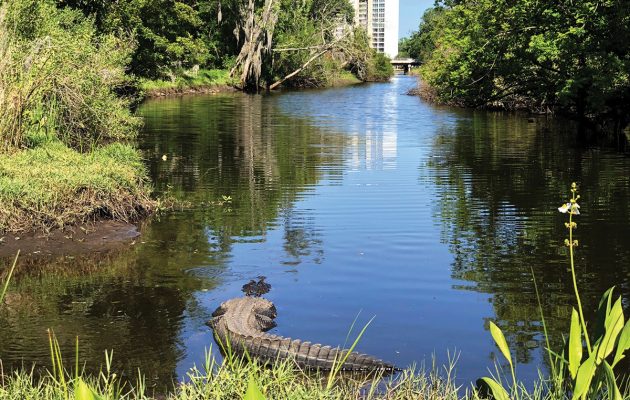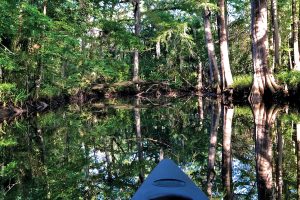Fishweir Creek restoration project moves into next phase with partnership agreement
Posted on July 1, 2018 By Editor Articles, Neighborhood News, Top Stories

In a few years, residents along Fishweir Creek may have an opportunity to swim with a manatee – that is if they aren’t concerned about the gators.
Big Fishweir Creek is classified by the Florida Department of Environmental Protection as a Florida Class III Waterbody, meaning it should be swimmable and fishable, according to the U.S. Army Corps of Engineers (USACE). But the creek, which meanders from the St. Johns River in Avondale then heads west toward Roosevelt Boulevard, has not been easily navigable for over a decade, maybe two.
That will change soon now that the Corps’ Jacksonville District Commander, Col. Jason Kirk, has signed a project partnership agreement with the City of Jacksonville for the Big Fishweir Creek Aquatic Restoration project. With the signed agreement, the aquatic restoration project now moves into the design and permitting phase, which should be complete in about a year. Actual project construction is subject to future federal and non-federal appropriations, but the Corps estimates the team will be ready to advertise a construction contract in July 2019, barring any unforeseen issues.
Due to urbanization, including encroachment along the banks of the creek, sediments transported by storm events have covered the natural creek bottom, causing a degradation of the natural habitat of the creek and its banks.
The project’s goal is to restore a healthy aquatic habitat in the Big Fishweir Creek ecosystem. The USACE wants to dredge the creek, reusing 32,000 cubic yards of sediment for the restoration and re-create a 2.3-acre manmade marsh island that defined the area decades ago. Dredging also will create two converging channels and deepen the creek.
The plan includes removing sediment, restoring habitat for manatees and other native species, removing exotic vegetation, restoring submerged and emergent aquatic vegetation, and restoring wetlands. The most notable benefit of the plan is the restoration of suitable habitat for the federally endangered manatee. Re-establishment of deep stream channels will once again allow manatee access and assist them in migration.
The Corps will host a community meeting in August to provide an update on the project, at which the public will have an opportunity to comment, but before the meeting occurs the Corps is addressing a concern that has been voiced by some residents, including Woodmere Drive resident Laurence Lee, since the project was first studied: the creation of a mid-channel island with the sediment removed from the creek.
Lee shared his concerns in a letter to The Resident in April, stating that his only opposition in the project was to the island, which he believes will affect the quality of life for property owners near the island.
In addition to obstructing his and his neighbors’ riverfront views, Lee expressed concern that the island would drive recreational river traffic too close to their docks, creating the potential for accidents and property damage. He also noted the island would attract flotsam and wondered who would be responsible for removing the litter he fears will accumulate around the island.
Studying the development of the island is one of several major aspects and challenges on the USACE’s list, which includes a topographic survey, soil sampling to determine potential contaminants, an archeological survey to check the channel for underwater vessels or anything of historic significance, and activities such as water-quality permits, quality-control review, real estate easements and identifying a staging area, among others.
“I want the team to be able to address the island. Can it be relocated, if so where, what’s the outcome of moving it, if it cannot be relocated, why?” said Jason Harrah, USACE Jacksonville District project manager, in an email. “I want to make sure we have answers to the public’s questions before we meet.”
In 2013, officials estimated the project’s cost to be $4.8 million with 65 percent coming from federal funds and 35 percent from the City. Today the price tag is around $6.5 million. “For every year that we have an authorized project that goes unconstructed we are required to complete an updated cost estimate,” said Harrah. “Since 2013 these costs have certainly gone up, and keep in mind the final cost also includes a contingency percent to allow for overruns in labor during design, etc.”

Pockets of natural flood plain are a key feature of some backyards on Fishweir Creek west of Herschel Street. Photo by Mike Webster
Residents express support
The increase in project costs is one of many reasons Fairfax Manor resident Stephanie Freeman would like to see the restoration project done sooner rather than later.
“In the 20 years that it has taken us to get to a funded partnership agreement with the Army Corps, both the federal and local costs are more than double than if we had done it when it was recommended,” Freeman said. “This is our opportunity to make a significant change. Fishweir Creek has been an impaired tributary for too long.”
Mark Walker said residents of Fairfax Manor have been working with the Corps since the 1990s to get the project off the ground. “It is exciting to see all the hard work of local river advocates culminate with the Project Partnership Agreement between the City of Jacksonville and the federal government. Also significant for Jacksonville is that 65 percent of this project will be paid for by an investment of federal dollars,” Walker said in an email.
Most residents along the creek, with properties on Woodmere Drive, Dupont Circle and Arden Street, are happy about the project.
“As a resident who lives on the creek, we see evidence of the deterioration of the waterway on a daily basis,” said Mark Rubin. “After Irma, we have noticed an incremental degradation of the quality of the water and the wildlife. Debris gets stuck in the silt and continues to add to the choking off of the creek. The entire community (humans and wildlife) will benefit from the improvements.”
Devon Sprague, who also lives in Fairfax Manor, said the project is much more than dredging and creating a manmade island. “The project engineers’ intuitive design will restore necessary habitat for the threatened Florida manatees and other aquatic species. Our silt-covered creek bed will be restored to naturally-occurring vegetation, a food source for manatees. The new island will serve as land reclamation, a crucial component of the ecosystem. Increased flow velocity and unblocked natural springs will once again provide fresh water for manatees, turtles, fish, etc.” he said. “Fishweir Creek was damaged by man going back almost 40 years ago and for the first time it’s getting a chance at full recovery. This is a multi-million-dollar gift from the Federal government to our community and the wildlife that we share it with.”
Adrian Genotti lives across the creek from the former Commander Apartment Tower and recalls paddling around the creek in the 1980s. “After passing the flats of cattails and marsh grass in the middle of the two channels at the mouth of the creek, the channels converged and remained too deep to find the bottom with my paddle. This depth continued all the way to the Roosevelt Boulevard culverts,” he shared in an email. “After returning from several overseas deployments in the early 2000s, I was shocked and disheartened to find this once charming waterway in my old neighborhood choked with mud and awash even at mid-tide, making it virtually impassable to the current generation of young explorers.”
Freeman expressed concern for her future neighbors across the creek at RiverVue, the new multi-family residential complex underway on St. Johns Avenue.
“This large complex is bigger in scale than expected and directly abuts Fishweir Creek. The developers’ plans have been to rent these units for $2,000+ per month,” she said. “There seems to be a lot of worry about the size and design of units and parking. However, the major concern citizens should have is of the view. If the units look out to muck, the success of this complex is jeopardized and will be problematic for our whole community. Only with a restoration of the area will there be true river views at RiverVue.”
By Kate A. Hallock
Resident Community News




 (2 votes, average: 4.50 out of 5)
(2 votes, average: 4.50 out of 5)




